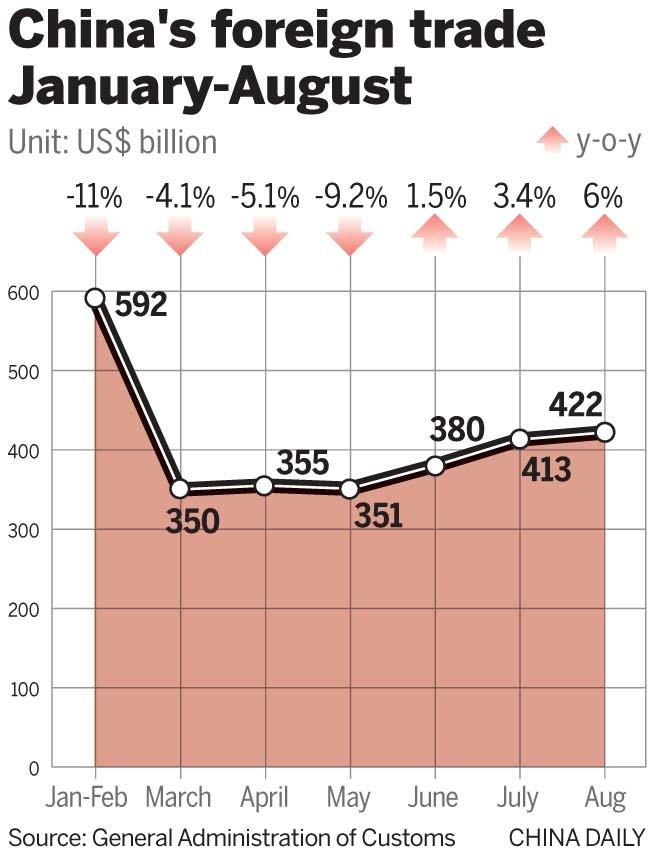 This undated photo shows two employees walking past the container terminal of Qingdao Port, Shandong province. (PHOTO / FOR CHINA DAILY)
This undated photo shows two employees walking past the container terminal of Qingdao Port, Shandong province. (PHOTO / FOR CHINA DAILY)
Despite global economic uncertainties amid the COVID-19 pandemic, China's foreign trade has maintained better-than-expected performance since the second quarter of this year, with trade in services, cross-border e-commerce and private sector transactions emerging as new growth engines, according to government officials and economic analysts.
In August alone, the country's exports surged by 11.6 percent, with imports dipping only 0.5 percent, according to the General Administration of Customs on Monday.
In August alone, the country's exports surged by 11.6 percent, with imports dipping only 0.5 percent, according to the General Administration of Customs
The easing of lockdowns by China's major trading partners has helped drive China's export growth recently, while the country's surging shipments to members of the Association of Southeast Asian Nations and exports of anti-epidemic materials also powered the growth momentum last month, said Yu Jianlong, secretary-general of the China Chamber of International Commerce.
China's foreign trade with ASEAN, now the country's largest trading partner, jumped 7 percent year-on-year to 2.93 trillion yuan (US$428.9 billion) from January to August. The country's trade with the European Union, its second-largest trading partner, grew by 1.4 percent on a yearly basis to 2.81 trillion yuan during the same period.
ALSO READ: China's foreign trade posts stable growth amid support measures
China is fully able to obtain a stable growth rate in foreign trade and help facilitate global economic recovery this year, thanks to the sustainable and stable improvement in trading activities in recent months and the country's fast-growing trade in services and other business sectors, such as e-commerce, according to Chen Wenling, chief economist at the Beijing-based China Center for International Economic Exchanges.
China's total foreign trade volume of goods reached 20.05 trillion yuan in the first eight months, down 0.6 percent year-on-year. The drop narrowed by 1.1 percentage points compared with the decline from January to July, according to Customs officials.

Whether this growth momentum can be sustained depends to a large extent on efforts in other parts of the world to contain the pandemic. If a second wave of the contagion occurs, it will definitely delay their economic recovery and affect China's external demand, said Sang Baichuan, an economics professor at the University of International Business and Economics in Beijing.
Fortunately, China's private companies, with more innovation input, are developing fast and taking a more important role in boosting the country's foreign trade, according to Sang.
Customs officials said the imports and exports of China's private companies reached 9.21 trillion yuan from January to August, up 8.5 percent year-on-year, accounting for 45.9 percent of the country's total foreign trade volume
Customs officials said the imports and exports of China's private companies reached 9.21 trillion yuan from January to August, up 8.5 percent year-on-year, accounting for 45.9 percent of the country's total foreign trade volume.
READ MORE: Cabinet pledges support for foreign trade
Zhang Wenxing, a production manager at Guizhou Zhuyun Paper Product Co in Guizhou province, said that exports as a proportion of his company's total business had risen from 70 percent to 90 percent in the first eight months of this year.
Due to the spread of the COVID-19, as many foreign manufacturers in the paper business have either suspended their production or shut down their factories to avoid health risks, the Chinese firm saw its global orders surge 30 percent this year. The company has its factories booked through November.
"Compared with tissue and other paper products, toilet rolls are in urgent need and have become the majority of our products to be shipped to overseas markets such as the United Kingdom, the United States, Singapore and Australia this year," Zhang said.
"Supported by strong market demand, we have gained more price bargaining power and gradually cultivated our own brands in overseas markets," Zhang said. He said the company used to rely heavily on making products to be sold under other brands.
Bjorn Rosengren, CEO of technology group ABB, a Swiss-Swedish multinational corporation, said that in addition to putting more resources into China's services trade sector, the company will start to run new robotics factories in Shanghai next year. The plant's products will not only serve the Chinese market, but also be exported.
ABB has established a major innovation and manufacturing hub in Xiamen, Fujian province, to further integrate its local businesses. The site is able to provide support services such as help desks and material management to ABB companies in China, Japan and South Korea, he said.
READ MORE: Trade winds blowing favorably for China
Despite a promising picture ahead for the country's foreign trade, Gao Lingyun, a research fellow at the Institute of World Economics and Politics of the Chinese Academy of Social Sciences, suggested the necessity to fend off risks caused by rising protectionism for the rest of the year.
With many countries still struggling to stimulate their exports and consumption, protectionism is harmful to the export-oriented companies, multinationals and the stabilization of financial markets, Gao said.
Since the pandemic has hit developing countries' economies harder than those of developed countries, Gao said that China needs to figure out more measures to stabilize trade ties with Africa and Latin American countries, and pay attention to the relocation of its labor-intensive industries to other markets in the next stage.
Contact the writers at zhongnan@chinadaily.com.cn


